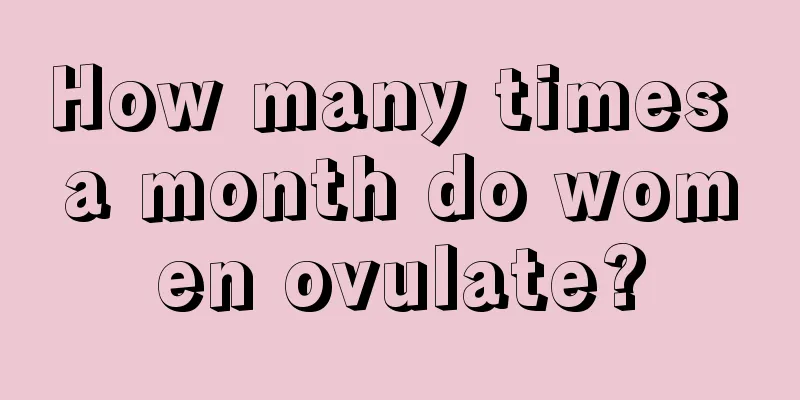How many times a month do women ovulate?

|
Many women who want to get pregnant and have their own children as soon as possible want to have a comprehensive understanding of how many times a woman ovulates in a month. The following content provides a comprehensive introduction for many women who want to know about this aspect. Therefore, in order to understand it as quickly as possible, you must have a specific understanding and knowledge of the following content so that you can be familiar with it. Ovulation cycle: a woman's ability to become pregnant is determined by her monthly ovulation cycle. Along with ovulation, there will be a menstrual period. Menstruation and ovulation are closely related, so be prepared for pregnancy at any time. Menstruation is a continuous process in which hormones constantly change, eventually leading to thickening of the endometrium, ovulation, and shedding of the endometrium if pregnancy does not occur. During your menstrual cycle, important events occur every day in the ovaries and endometrium. Every month an egg must be selected and stimulated to mature, and the endometrium must be prepared in case a fertilized egg (embryo) unexpectedly arrives and implants and grows there. Menstruation is often called "period" because it occurs about once a month for most women. Some people believe that menstruation should align with the normal calendar, but menstruation does not occur on the same day of each month because the months on the calendar are not equal in length, and because the human body is not a clock, each woman has some variation between cycles. To measure the number of days in a menstrual period, you can take the day when menstrual bleeding begins as the first day of menstruation. The average number of days for a menstrual period is about 28 days. To be more precise, the average number of days for a menstrual period varies at different stages of a person's life. It is about 30 days at the age of 20, and about 26 days when you are approaching menopause at the age of 50. Only a very small number of women actually have a menstrual period of 28 days, but a period of 24 to 35 days is considered a normal period. A woman's physical condition varies from one month to the next, and it is rare for a woman to have periods that are exactly the same length. After understanding the above introduction, I believe you also know how many times a woman generally has ovulation periods in a month. The above content comprehensively introduces this knowledge. Therefore, for women who want to understand it as soon as possible, you can have a comprehensive understanding of the above content. I believe that through understanding, you will have a comprehensive understanding of this knowledge. |
<<: What are the dangers of having sex on the last day of ovulation?
>>: What are the reasons for maternal skin itching
Recommend
Progesterone pictures
Every time my menstrual period is irregular, I al...
Itchy pubic hair
If the pubic hair is itchy, most patients are inf...
How to treat ovarian cyst syndrome?
Ovarian cysts are one of the most common gynecolo...
What is the cause of brown discharge in leucorrhea?
There are many common problems with leucorrhea. Y...
Is it still necessary to have an abortion for threatened miscarriage?
With the increase of life pressure and the aggrav...
Pay attention to pediatric diarrhea and help your baby grow up healthily.
Pediatric diarrhea, or diarrheal disease, is a gr...
Why is Zhacai called Zhacai? Is Zhacai a hair-raising food?
Many nutrients in mustard tuber are essential to ...
Can early pregnant women eat watermelon in daily life?
Pregnant women in the early stages must pay atten...
What are the precautions for moxibustion? What should I pay attention to after moxibustion?
Moxibustion mainly stimulates the meridians throu...
Symptoms during the first month of pregnancy
In the early stages of pregnancy, the symptoms ar...
What medicine should I take to delay my period?
Irregular menstruation is a common gynecological ...
Can pregnant women eat pig intestines?
After a pregnant woman becomes pregnant, there ar...
Why do women grow beards?
Everyone knows that beard is the second character...
Can hot compress be used to treat pelvic inflammatory disease?
Pelvic inflammatory disease is a very common gyne...
Precautions for removing the IUD
Contraceptive rings are very common. You must pay...









